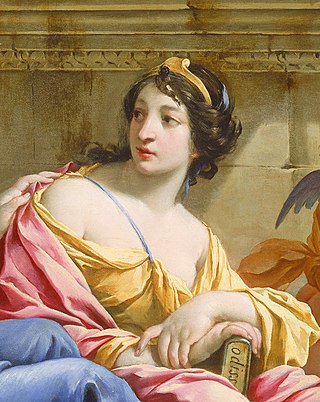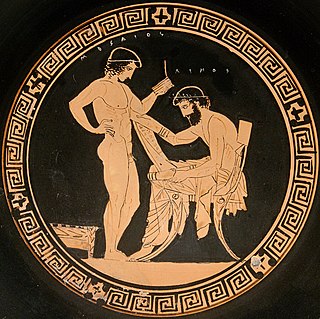Related Research Articles

Apollo is one of the Olympian deities in classical Greek and Roman religion and Greek and Roman mythology. Apollo has been recognized as a god of archery, music and dance, truth and prophecy, healing and diseases, the Sun and light, poetry, and more. One of the most important and complex of the Greek gods, he is the son of Zeus and Leto, and the twin brother of Artemis, goddess of the hunt. He is considered to be the most beautiful god and is represented as the ideal of the kouros. Apollo is known in Greek-influenced Etruscan mythology as Apulu.

Arion was a kitharode in ancient Greece, a Dionysiac poet credited with inventing the dithyramb. The islanders of Lesbos claimed him as their native son, but Arion found a patron in Periander, tyrant of Corinth. Although notable for his musical inventions, Arion is chiefly remembered for the fantastic myth of his kidnapping by pirates and miraculous rescue by dolphins, a folktale motif.

In Greek mythology and ancient Greek religion, Mnemosyne is the goddess of memory and the mother of the nine Muses by her nephew Zeus. In the Greek tradition, Mnemosyne is one of the Titans, the twelve divine children of the earth-goddess Gaia and the sky-god Uranus. The term Mnemosyne is derived from the same source as the word mnemonic, that being the Greek word mnēmē, which means "remembrance, memory".

In ancient Greek religion and mythology, the Muses are the inspirational goddesses of literature, science, and the arts. They were considered the source of the knowledge embodied in the poetry, lyric songs, and myths that were related orally for centuries in ancient Greek culture.
In Greek mythology, Melete was one of the three original Boeotian muses before the Nine Olympian Muses were founded. Her sisters were Aoede and Mneme. She was the muse of thought and meditation. Melete literally means "ponder" and "contemplation" in Greek.

Urania was, in Greek mythology, the muse of astronomy and astrology. Urania is the goddess of astronomy and stars, her attributes being the globe and compass.

In Greek mythology, Niobe was a daughter of Tantalus and of either Dione or of Eurythemista or Euryanassa. Niobe was the wife of Amphion and the sister of Pelops and Broteas.

In Greek mythology, the satyr Marsyas is a central figure in two stories involving music: in one, he picked up the double oboe (aulos) that had been abandoned by Athena and played it; in the other, he challenged Apollo to a contest of music and lost his hide and life. Literary sources from antiquity often emphasize the hubris of Marsyas and the justice of his punishment.

In Greek mythology, the Charites or Graces were three or more goddesses of charm, beauty, nature, human creativity, goodwill, and fertility. Hesiod names three – Aglaea ("Shining"), Euphrosyne ("Joy"), and Thalia ("Blooming") – and names Aglaea as the youngest and the wife of Hephaestus. In Roman mythology they were known as the Gratiae, the "Graces". Some sources use the appellation "Charis" as the name of one of the Charites, and equate her with Aglaea, as she too is referred to as the wife of Hephaestus.
In Greek mythology, Thamyris was a Thracian singer. He is notable in Greek mythology for reportedly being a lover of Hyacinth and thus to have been the first male to have loved another male, but when his songs failed to win his love from the god Apollo, he challenged the Nine Muses to a competition and lost.

In Greek mythology, Calliope is the Muse who presides over eloquence and epic poetry; so called from the ecstatic harmony of her voice. Hesiod and Ovid called her the "Chief of all Muses".

Music was almost universally present in ancient Greek society, from marriages, funerals, and religious ceremonies to theatre, folk music, and the ballad-like reciting of epic poetry. This played an integral role in the lives of ancient Greeks. There are some fragments of actual Greek musical notation, many literary references, depictions on ceramics and relevant archaeological remains, such that some things can be known—or reasonably surmised—about what the music sounded like, the general role of music in society, the economics of music, the importance of a professional caste of musicians, etc.
In Greek mythology, Corybas is the son of Iasion and the goddess Cybele, who gave his name to the Corybantes (Koribantes), or dancing priests of Phrygia. The Korybantes were associated with Orpheus, another son of Apollo and a Mousa, founder of the closely related Orphic Mysteries.
In Greek mythology, Nete (Νήτη) was one of the three Muses of the lyre that were worshipped at Delphi, where the Temple of Apollo and the Oracle were located. Her name was also the lowest of the seven notes of the lyre. Her sisters that were worshipped along with her were Hypate and Mese. These three muses were comparable to the original three, Aoide, Melete, and Mneme. Alternatively, they were Cephisso, Apollonis, and Borysthenis, which portrayed them as the daughters of Apollo.
In Greek mythology, Mese was one of the three Muses of the lyre together with her sisters Nete and Hypate. They were worshipped at Delphi, where the Temple of Apollo and the Oracle were located. Mese was the Muse of the middle cord of the seven noted lyre and represented one of the three strings of the said popular Greek musical instrument.
Apollonis was one of the three younger Mousai Apollonides (Muses) in Greek mythology and daughters of Apollo, who were worshipped in Delphi where the Temple of Apollo and the Oracle were located. The three sisters, Cephisso, Apollonis, and Borysthenis, are also known as Nētē, Mesē, and Hypatē where their names are synonymous with those of the lowest, middle, and highest chords of a lyre, further characterizing the Muses as the daughters of Apollo.

The kithara, Latinized as cithara, was an ancient Greek musical instrument in the yoke lutes family. It was a seven-stringed professional version of the lyre, which was regarded as a rustic, or folk instrument, appropriate for teaching music to beginners. As opposed to the simpler lyre, the cithara was primarily used by professional musicians, called kitharodes. In modern Greek, the word kithara has come to mean "guitar", a word which etymologically stems from kithara.

In Greek mythology, Orpheus was a Greek bard, legendary musician and prophet. He was also a renowned poet and, according to the legend, travelled with Jason and the Argonauts in search of the Golden Fleece, and even descended into the underworld of Hades, to recover his lost wife Eurydice. Orpheus was also called the ruler of Bistonian Pieria.
Pyknon, sometimes also transliterated as pycnon in the music theory of Antiquity is a structural property of any tetrachord in which a composite of two smaller intervals is less than the remaining (incomposite) interval. The makeup of the pyknon serves to identify the melodic genus and the octave species made by compounding two such tetrachords, and the rules governing the ways in which such compounds may be made centre on the relationships of the two pykna involved.

In Greek mythology, Linus was a reputed musician and master of eloquent speech. He was regarded as the first leader of lyric song.
References
- ↑ Williams, Charles Francis Abdy (1903). The story of notation (1st ed.). London: London, The Walter Scott publishing co., ltd.; New York, C. Scribner's sons. pp. 11–13.
- "MUSES, MUSAE, Greek Mythology Index". Myth Index. 2007. Retrieved 2007-12-29.